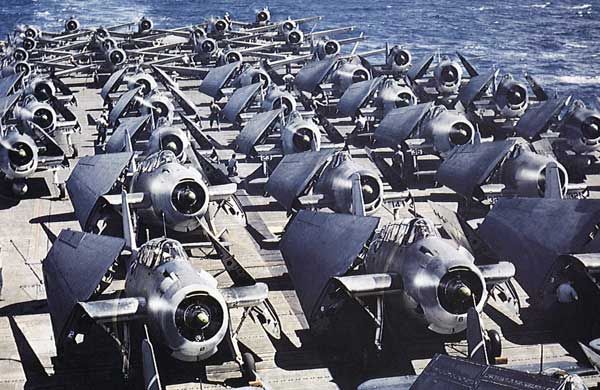AZrailwhale
Diamond Member
No, I was just making an informative comment on a ship design oddity.Does that arrangement have the two vehicles moving in the opposite direction during flight operations?
Follow along with the video below to see how to install our site as a web app on your home screen.
Note: This feature may not be available in some browsers.
No, I was just making an informative comment on a ship design oddity.Does that arrangement have the two vehicles moving in the opposite direction during flight operations?
No, most carriers during the inter-war years and the early war years had centerline elevators. USS Wap was the first carrier that I know of with a deck-edge elevator, and it was a pretty ramshackle affair. The first carriers to have real deck edge elevators were the Essex class which had one on the port (left facing forwards) side. Modern USN carriers have deck-edge elevators on both sides.Forgive my ignorance on the topic but I'm assuming that the direction the plane is landing and the direction the carrier is moving have to be roughly the same heading more or less. Does it have to be like the exact degree? Like if the heading is 180--due south...does the plane have to be headed 180 degrees too or can it "get away with" 178 or 182???
I imagine the elevator that brings the planes up to the flight deck is only on one side of the ship. So would it mean that the ship has to have the planes land to where they eventually stop is by that elevator?
Fun stuff to think about....
There were arresting wires on the forward part of the deck. Arresting wires fold flat to the deck when not in use so as not to interfere with aircraft handling. The barriers were not generally nets but several cables on a strut. Nets tangled up in props and aircraft parts and took a long time to clear while tying up the deck so no other aircraft could land.And steaming into the wind as well.
Note that the class was designed in late 1930s and commissioned 1941-42, when aircraft were transitioning from bi-wing to mono-wing and most landing speeds were in range of 80-100mph. And normally there were no arresting wires* for the hook to grab since such would interfere with the catapults on the bow deck. 2 of the 3 in the class were sunk early in the war, only the Enterprise survived to post-war.

USS Yorktown (CV-5) - Wikipedia
en.wikipedia.org

List of aircraft carriers of the United States Navy - Wikipedia
en.wikipedia.org
* Arresting wires are strung crosswise on the rear of the flight deck with intent of the landing aircraft snagging one with it's tail-hook when touching down on the deck as landing. In the older, "straight deck" design of carriers, there was a landing signal officer to direct the aircraft that was landing and if the approach was not correct, the pilot would get a wave-off and have to circle around for another try. Usually there was a net strung across the flight deck about mid-ship to catch the aircraft should the hook miss snagging an arrestor wire.
I'm fairly certain there were no arresting wires on forward areas of flight deck on CVs built in late 1940s on to present, since such would be over and crosswise to the catapults in the deck and would prevent the catapult from operating. It would snag on the perpendicular wires crossing it's track.There were arresting wires on the forward part of the deck. Arresting wires fold flat to the deck when not in use so as not to interfere with aircraft handling. The barriers were not generally nets but several cables on a strut. Nets tangled up in props and aircraft parts and took a long time to clear while tying up the deck so no other aircraft could land.






